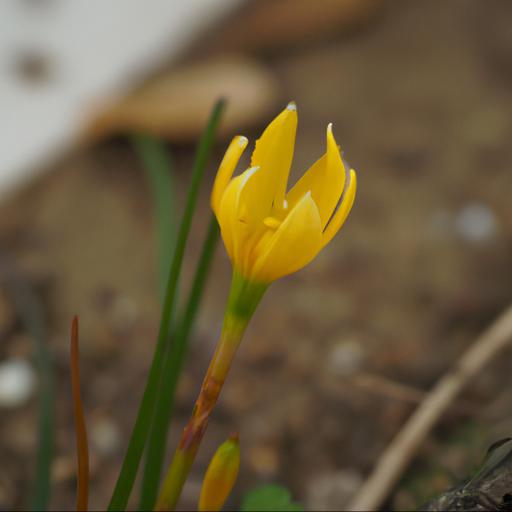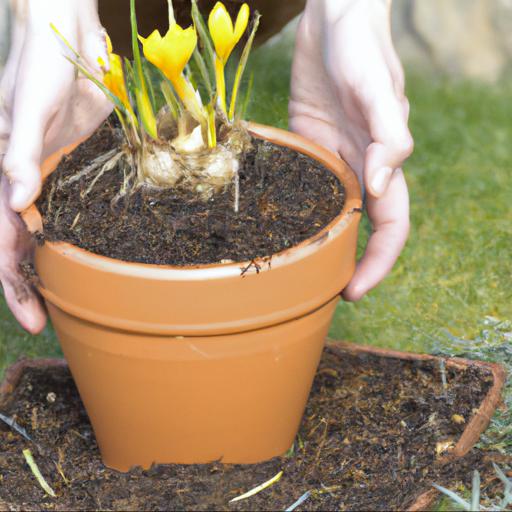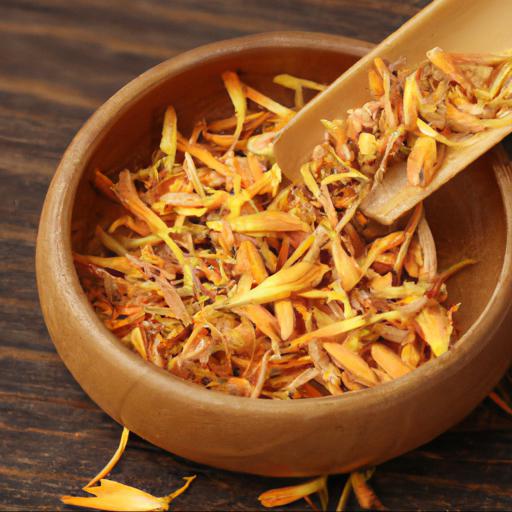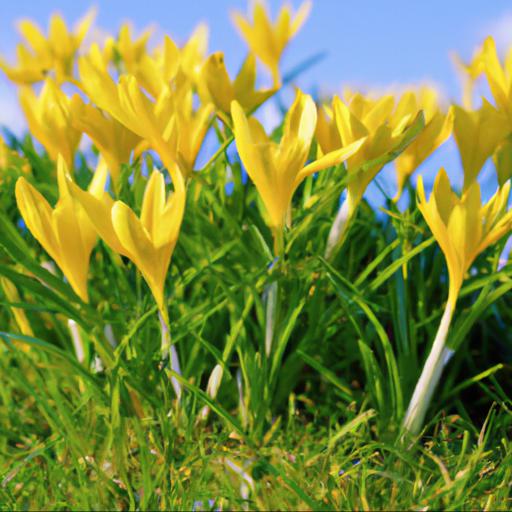Sternbergia lutea is a species of flowering bulbous plant, native to the Mediterranean region. It is a member of the Amaryllidaceae family, and is commonly known as the ‘Autumn Daffodil’ or ‘Winter Daffodil’. This plant is known for its bright yellow flowers, which bloom in autumn and winter.
The blooms are often used as cut flowers in floral arrangements, and the bulbs are planted in gardens for ornamental purposes. Sternbergia lutea is a hardy plant, and can tolerate a wide range of soil conditions, making it an excellent choice for gardeners.
It is also quite easy to cultivate, and can be grown in pots or in the ground. With its bright yellow blooms, Sternbergia lutea is a great way to add a splash of colour to your garden during the colder months.
Characteristics of sternbergia lutea

:When it comes to the perfect, classic garden plants, it’s hard to look past the beautiful Sternbergia lutea. This plant is an evergreen, bulbous perennial that’s native to Central and Southern Europe, so it has a long history, having been grown in gardens for centuries.
Sternbergia lutea has a few trademark characteristics that make it stand out in the garden. It is an extremely hardy plant, able to tolerate cold temperatures and fairly dry conditions. Its foliage is attractive, with its strappy, emerald leaves that have a waxy appearance, creating an attractive contrast with the yellow flowers that appear in late autumn and last until early winter.
Sternbergia lutea not only looks beautiful, it also requires minimal care from gardeners. It stores energy in its bulbs so it can survive when the conditions are poor, and it is also very resistant to most pests and diseases. With its hardiness, it makes a great addition to any garden where it can be planted in full or partial sun, or even in containers or rock gardens.
It’s an ideal choice for anyone looking to add a tough, reliable and stunning garden plant to their outdoor space.
Growing and caring for sternbergia lutea

As the crisp autumn days begin to settle into the seasons, many gardeners look to brighten up their outdoor spaces with the cheerful blooms of the Sternbergia lutea flower. Bright and cheerful, this perennial bulb is hardy and easy to care for, making it an ideal choice for landscaping beds, border gardens, and even containers.
Sternbergia lutea is also referred to as “weak onion” and is a member of the Amaryllidaceae family. Its bell-shaped flowers bloom early in the autumn, featuring yellow petals and dark anthers, and will remain until just before frost. Plant Sternbergia lutea in full sun to partial shade in well-drained soil; in addition, it’s an appropriate choice for rock and water gardens.
A great choice for the novice gardener, once planted, this evergreen bulb requires little maintenance and is frost tolerant, as long as it’s grown in a mild climate zone. The key to successfully growing this flower is to ensure that the bulb remains well-hydrated during its bloom season, so be sure to water the bulbs every few weeks. Sternbergia lutea is also prone to rot, so good air circulation is essential to prevent this, and removing dead foliage will also help.
Once the flowers have finished blooming, cut back the foliage to the ground and mark the spot in order to ensure that you know where they are planted when they return the following year. By following these simple guidelines, Sternbergia lutea can make a statement in your garden, providing you with its warm yellow blooms for years to come.
Use its cheerful flowers to brighten up your autumn days and add a touch of color to your garden.
Uses of sternbergia lutea

. When it comes to creating a dazzling display of color in gardens around the UK, Sternbergia lutea have you covered. These awe-inspiring autumn flowering bulbs are commonly referred to as ‘autumn daffodils’, and are renowned for the brightly coloured yellow and orange flowers that adorn their stems.
These vibrant blooms on pointed, thin stems give Sternbergia lutea an unmistakable look, and they are often seen in formal and informal garden settings alike. Popular among flower beds, borders and even pots, they can provide an unmissable addition to any outdoor space.
Upon planting, Sternbergia lutea will begin to produce their first flowers within two to three years. In addition to providing beauty and colour, Sternbergia lutea are also highly drought tolerant and an ideal addition to gardens with limited supply of water.
Despite preferring full sun, the plants can tolerate light shade, and are ideal for use in the summer where their drought tolerance can really show its true colours.
Interesting facts about sternbergia lutea
As an experienced UK garden expert, I would like to use this opportunity to shed light on the captivating facts about the beloved Sternbergia lutea. The flower comes from the Amaryllidaceae family and is found in Mediterranean habitats. Sternbergia lutea is a pretty and eye-catching flower; it is native to southwestern Asia and Cyprus.
The flowers are quite small and need to be looked for carefully. The flowers of this species bloom in autumn time, with their cup-shaped petals have a yellow, orange, or white hue.
This plant is very adaptable and has been growing in the United Kingdom for centuries, though it flowers best in warm, sheltered areas. It not only adds a splash of golden colour to your garden, but also provides early nectar for beneficial pollinators in autumn.
It grows in soil which is set in semi-shade and most soils along with regular watering, it even tolerates dry spells. Additionally, it doesn’t require much maintenance as it flowers once a year and makes a stunning and cheerful sight come the autumn months. Overall, the Sternbergia lutea is a lovely stunning flower which is easy to maintain and grows well in the British climate.
It is the perfect addition to the garden, creating a sense of joy and atmosphere in autumn when everything else is wilting away from the summer warmth.
Final Touch
Sternbergia lutea is a flowering bulbous plant native to the Mediterranean region. It produces yellow flowers in the autumn and has a pleasant fragrance.
The plant is easy to grow and can thrive in well-drained soil in sunny locations. It is a popular choice for gardeners looking for a low-maintenance, drought-tolerant plant that will add color and fragrance to the garden. Sternbergia lutea is an excellent choice for anyone looking for a bright, cheerful addition to their garden.
FAQ
What is the scientific name of Sternbergia lutea?
The scientific name of Sternbergia lutea is Sternbergia lutea.
Where is Sternbergia lutea native to?
Sternbergia lutea is native to the Mediterranean region, from southern Europe to western Asia.
What are the characteristics of Sternbergia lutea?
Sternbergia lutea is a bulbous perennial plant with yellow flowers that bloom in the fall. It has long, narrow, grey-green leaves and a bulb that can reach up to 8 cm in diameter. It is native to southern Europe and the Mediterranean region and prefers well-drained soils and full sun. It is drought tolerant and can tolerate temperatures down to -15°C.
How does Sternbergia lutea reproduce?
Sternbergia lutea reproduces by seed, which is spread by wind or animals.
What is the ideal growing environment for Sternbergia lutea?
The ideal growing environment for Sternbergia lutea is a sunny spot with well-drained soil. It prefers a dry, sandy soil and can tolerate drought conditions. It also needs protection from strong winds.
What are the benefits of growing Sternbergia lutea?
The benefits of growing Sternbergia lutea include its ability to attract pollinators, its low-maintenance needs, its drought-tolerance, and its vibrant yellow flowers that bloom in the fall.

